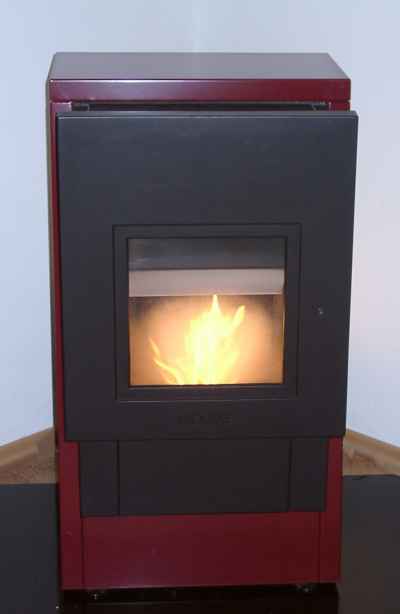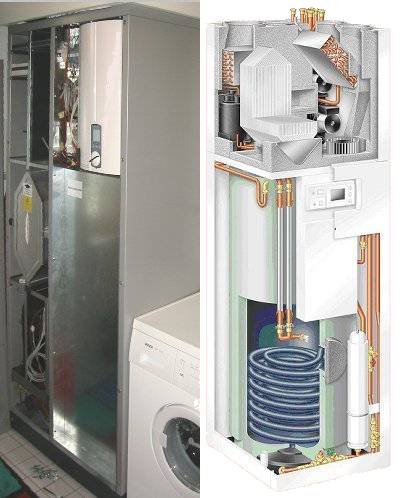| |
This will only work in a Passive House: Heating with nothing other than fresh air |
|
This is the know "classical" compact unit: all building services are realised in one handy appliance:
- heating,
- ventilation and
- domestic hot water.
Everything is centred on the element of air: air is the medium that transports the heat (on the supply side), air is the heat source of the heat pump (on the exhaust side). Of course, if necessary, the air could be cooled and dehumidified as well, using the same equiment - that might be interesting in hot climates.
Note that only the fresh air required for indoor air quality is used, there is no recirculated air. That is a difference to the systems in wide use e.g. in the US; those use only recirculated air and a far higher air flow rate.

Fireplace, which is the main heating system in a passive house in Friedberg (architect: Blumrich); this automatic oven is also heating domestic hot water; during summer thermal solar collectors top the concept off.

Compact Units available on the market.
Idea #1: Use the fresh air required for indoor air quality also for heating the building
A building occupied by human beings needs fresh air. If the fresh air supply is left to good luck, it should not surprise if indoor air quality (IAQ) worsens.
If on the other hand the heat from the exhaust air is not recovered, there will be significant ventilation heat losses. It is impossible to realise an energy efficient building in this way - especially if the indoor air quality is to be high as well.
Therefore, for energy efficient new construction or refurbishment a mechanical ventilation with heat recovery is really necessary - this at least holds for cold climates (climates, in which one needs a heating system) and in hot climates (climates, in which one needs active summer cooling). For a detailed discussion of this point, have a look at our page on the topic ventilation.
The supply air, which is delivered by the air-to-air heat exchanger, can transport some heat, too. It is not a huge amount, but just 10 W/m² can be delivered to the supply air rooms using the fresh air required for good IAQ (see the calculation on heating capacity of fresh air). That will not be sufficient at all in conventional houses. But in a passive house, the peak heat load requirement is extraordinary low. Indeed, it will be so low that these 10 W/m² available from a fresh air supply will be sufficient (that in fact is the defining condition for a passive house). Thus, some simplified building services systems become possible in passive houses: “Heating with the ventilation system”, without the need for additional ducts or even without the need for a higher duct cross-section dimension. If, in addition, the heater for the supply air is integrated within the ventilation system and the domestic hot water boiler, one ends up with an integrated compact unit:
Heating, ventilation, domestic hot water and cooling (if necessary) can be supplied by just one appliance. Many solutions can be chosen for heat generation:
- Use of a small heat pump (Compact unit with heat pump, see figure at left hand side)
- Use of a small condensing burner (natural gas compact unit)
- Use of a small combustion unit for biomass fuel (e.g. straw-pellets).
Idea #2: Heating with the remnant energy
of the exhaust air: Compact unit with heat pump
The remnant heat in the exhaust air after the air-to-air heat exchanger does not yield very much heat. To be exact, we have to talk about the "enthalpy", because a main part is delivered by the humidity in the air, which condensates. Again, in a passive house the heat requirement is very low, so very low, that it can be realised almost completely by the remnant exhaust air enthalpy. This discovery was published in 1995 by Wolfgang Feist. That was the beginning of the compact unit systems development.
In the meantime there are more than ten providers producing such compact units with small heat pumps. These appliances are highly efficient - monitoring in Passive House settlements has proven that..
Idea #3: Heating using biomass: The pellet compact unit
Of course, heating with biomass is not only available in passive houses. But the potential total amount of energy from biomass is limited - as long, as the cultivation method is kept sustainable. If the effciency of the energy use is poor, only a small fraction of the buildings in Europe may be heated by biomass - that will hold world wide as well with some exceptions in remote regions. But if efficiency is high enough, e.g. if the passive house requirements are met, then the fuel potentially produced by a sustainable agriculture and forestry can be sufficient to supply a major portion of the energy demand.
The German biomass potential (some 90 Billion kWh/a at maximum) is sufficient to cover 16% of the contemporary heating requirement of all households. If the efficiency of the buildings is increased to the level of passive houses (i.e. a factor 5), the same energy will be sufficient to heat 79% of all domestic buildings.
High efficiency is an advantage for the users as well: One "problem" of biomass always was the handling of the fuel, it was in fact an important reason why people changed to central heating and the use of oil as a fuel. But if the peak heat load for a whole dwelling is reduced to 1 or 2 kW, the biomass heating system will be just a small box, placed in the living room and sufficient to heat the whole home. Most people like to have a fireplace in the living room. In a passive house, an improved version of a fireplace could be the main heating system. That results in many advantages:
- The biomass oven ("fireplace") will run fully automatically as one is used to with modern heating systems.
- Fuel requirement will be just a few kilograms per day..
- Therefore the place needed to store the fuel is quite small.
- It even would be possible to buy the fuel once a weak during food shopping.
- The combustion air required for the oven could be supplied by the ventilation system, too.
- And the flue gas could be discharged via the exhaust duct of the ventilation, too - no additional chimney or flue pipe would be needed.
All these advantages are available if and only if the peak load demand is very low - otherwise higher capacities, additional ovens in other rooms, flue pipes etc. will become necessary.
This is a quite simple concept, relying completely on renewable energy, which will work in passive houses. There are already some passive houses using this concept (passive houses Friedberg (German)).
Idea #4: Heating with condensing units: A compact unit using natural gas
Everybody using a gas stove knows that small and clean heat generators are available using natural gas (or liquid gas). Nethertehless, it took some time until such a postheater became available for a compact ventilation unit in passive houses. The advantages are at hand here, too:
- The condensing combustion unit only requires a very low combustion air volume. The ventilation system, heart of any compact unit, can easily supply this combustion air on the way. Therefore, an additional combustion air duct becomes dispensable.
- In the condensing combustion unit there will be condensate that has to be disposed to the sink. But in a ventilation system with a heat recovery there already is a sewer pipe for the condensate that may occur at the heat exchanger. The sewer pipes can be combined to save costs.
- The flue gas from the condensing combustion will need a flue pipe. Again, this is already available with the exhaust duct of the ventilation system: A precondition to use that is, however, that the peak load is very small and there is only a small amount of flue gas - and, of course, there has to be a concept for secuity against back drafts.
11th Conference on Passive Houses
Compact units combined with the ventilation system are not the only solutions for the building services in passive houses: There are solutions using natural gas, wood pellets and innovative electrical systems, too - this discussion will be held at the conference. In addition, systems using solar thermal collectors have an outstanding performance.
At
the exhibition
technologies
for passive houses will be demonstrated:
Efficiency and renewable energy complement one another very well: If the energy requirement is as low as in a passive house, solar energy can cover the main part of the demand.
(updated: 2006-09-23 Author: W. Feist thanks to Peter Cox for proof reading© Passive House Institute; unchanged copy is permitted, please give reference to this page)